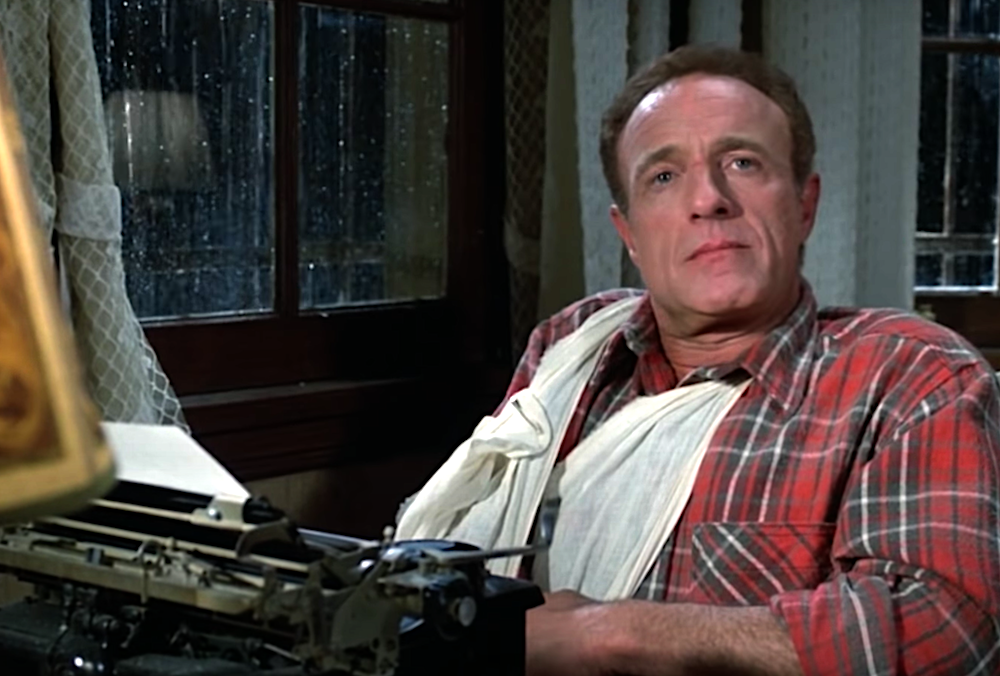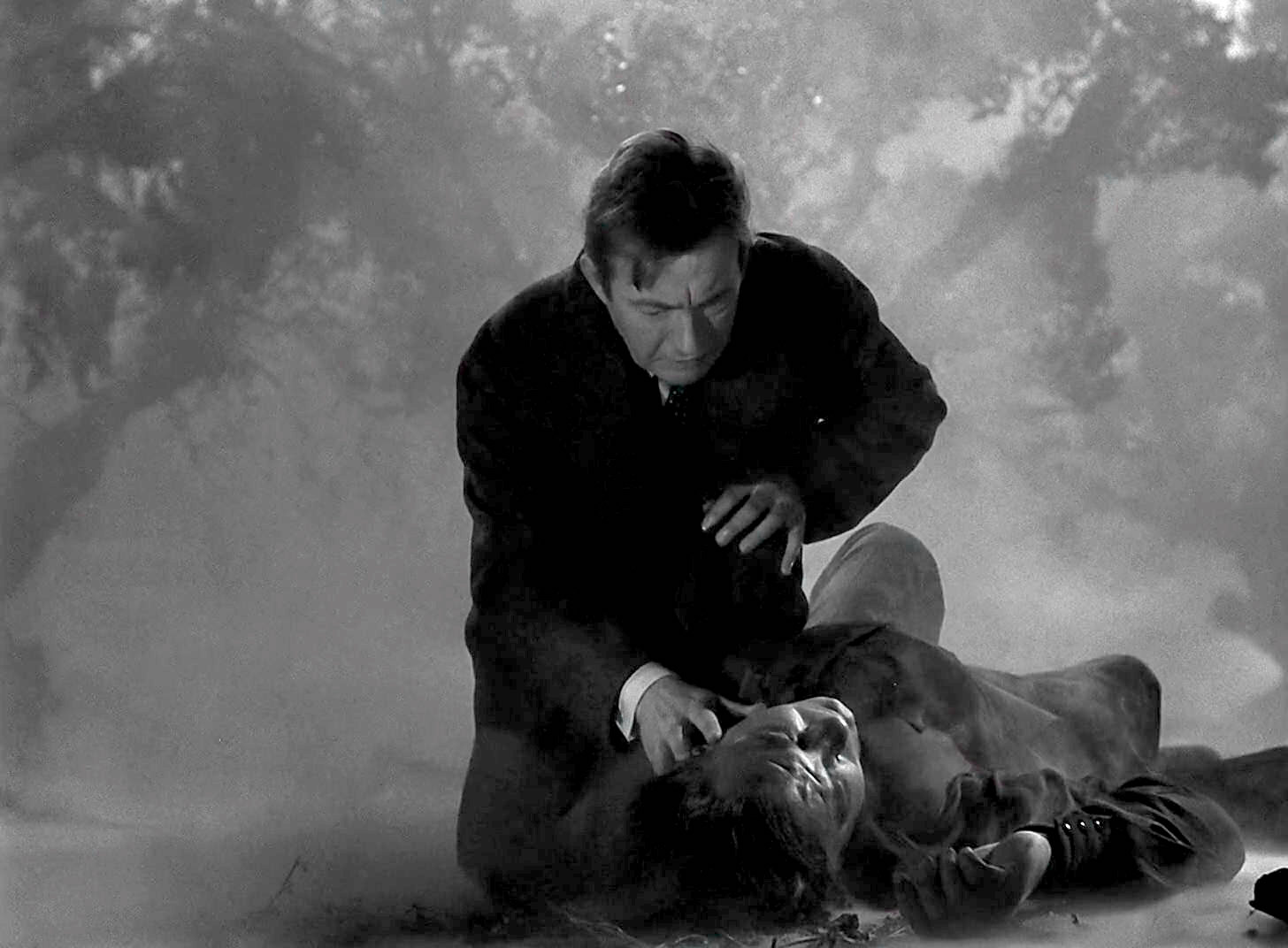Books & Culture
“Misery” Is a Horrifying Love Letter to the Physical Act of Writing
Rob Reiner's film adaptation of Stephen King's novel celebrates an experience of the writing process we've all but lost in the digital age

A cigarette, a match, a bottle of booze, black letters inked rapidly onto white paper—and, erupting over each of these tranquil images, the hard staccato and carriage return rings of a typewriter. A hand yanks a completed page from the machine with a snap, and, picking up a pencil, writes out “THE END”; soft scratch of graphite on paper. The author lights a cigarette with the satisfaction of a man who’s just made love to his typewriter, and as he inhales slowly, we can almost taste the tobacco. He pours himself some champagne, the liquid gurgling as it enters the glass. Paul Sheldon (James Caan), the protagonist of Misery, has just completed his latest manuscript, a novel he believes to be his magnum opus. And as the film’s first shots introduce him, they are also introducing us to one of Misery’s preoccupations: writing as somatic experience, a craft indelibly shaped by the writer’s physical surroundings, tools, and body.
Reiner’s fetishistic tribute to the sensory joys and material apparatus of writing is all the more noteworthy because no such scene appears in the source text on which the film is based. Stephen King’s 1987 novel Misery instead begins in miseria res: a grievously injured Paul lies in bed, already at the mercy of Annie Wilkes (Kathy Bates), his deranged “number-one fan.” By first lingering on the potential pleasures of the text, on the other hand, Reiner’s film deliberately establishes a dramatic contrast between the material conditions under which literary creation can occur. From the cozy hotel room where Paul finishes his book, body intact and spirit buoyed by creature comforts, the film turns swiftly towards a study of writing in pain and under duress.
While driving home from the hotel through a snowstorm, Paul totals his car, shattering both of his legs. The violently unstable Annie pulls him from the wreckage and imprisons him in her secluded home under the pretense of healing his car crash wounds. Among other tortures, she forces him to rewrite the most recent installation of his Misery Chastain novels, the lowbrow historical romances that made Paul famous but which he has come to loathe.
In Reiner’s film, writing is not just bodily—it is bodily survival.
The movie’s second and third acts are thus dominated by the spectacle of a maimed Paul grimly churning out Misery’s Return, the revised book that Annie demands. In a sense, the scenario is simply the “potboiler” idiom made more literal and more lethal. Before the accident, Paul churned out trash novels to feed himself. Now, Annie threatens to murder him unless he fictionally resuscitates Misery, the lead character whom he had cheerfully killed off in the published version of the book (and whose odd name crystallizes the film’s interest in the links between fiction and the flesh). As he writes Misery back to life, Paul also keeps himself alive, like a flannel-clad Scheherazade. In Reiner’s film, then, writing is not just bodily—it is bodily survival.
This setup means that Misery ends up dedicating a substantial chunk of its runtime—more, I would hazard, than the average movie about authorship—to depicting the writing process. So, too, must Paul weaponize his drafting process and writing instruments themselves in order to stay alive. It’s for these reasons that Misery serves as an unusually revealing time-capsule of literary production from the age of typewriters and pencils. To re-watch the film after the digital revolution is to witness an accidental testament to how dramatically the physical experience of writing has changed since 1990.
Because it is set in the ‘80s, Misery’s plot crucially hinges on the simultaneous power and precarity of physical manuscripts in the days before laptops, google docs, and hard drives. The sensual affection with which the movie’s first scene depicts paper-based writing is soon revealed to be a reflection of Paul’s own enjoyment of the corporeal side of his profession. When he pulls the novel’s final page out of the typewriter to slowly inscribe “THE END” by pencil instead of by keyboard, his reverent expression suggests that he’s done so largely to gain skin-to-skin contact with the thing he’s written, to lovingly feel its weight in his hand.
In fact, it’s in part Paul’s bodily attachment to the document he’s created that eventually dooms him. When his car starts to skid out of control on a snowy mountain road in the next scene, Paul instinctively reaches over—twice—to make sure the satchel holding his precious manuscript doesn’t slide off the passenger seat. In doing so, he removes one hand from the wheel and his attention from the road ahead, loses control over the swerving vehicle, and careens off an embankment.
To re-watch the film is to witness an accidental testament to how dramatically the physical experience of writing has changed since 1990.
It’s not just Paul’s attachment to the physical manifestation of his craft that makes him protect this manuscript with irrational intensity, however. We later learn that he observes a superstitious practice of making no additional copies of the first draft of a new book. It would spell an immeasurable loss if something were to happen to the document in the briefcase. This is the less pleasant flip side of writing’s tangible paper form: the distressing frailty of a physical product that can be damaged, destroyed, lost in an instant. Misery’s main characters are both all too aware of this delicateness, and both will weaponize it to their own devastating advantage.
Over the course of Reiner’s film, Annie proves herself capable of grotesque physical abuse: she has a history of murdering infants in the maternity wards where she used to work, makes clear that she plans to shoot Paul when he finishes the Misery rewrite, and, in one of cinema’s more infamous scenes, “hobbles” Paul’s ankles with a sledgehammer when she suspects he’s been trying to escape. Yet one of Annie’s cruelest acts is one of literary, rather than bodily, violence. Having found Paul’s newly minted manuscript inside his crashed car, she reads it—and determines it’s not worthy of her favorite author. As a none-too-subtle caricature of an unsophisticated but demanding reading public, Annie adores Paul’s Harlequin-esque Misery series, but fails to appreciate the more “serious,” modern, and implicitly masculine turn that Paul has taken with his latest book, which centers on a tough-talking kid from the inner city. (In creating Annie, King reportedly drew on his own experience with domineering fans, who raged against his decision to switch out his accustomed horror genre for epic fantasy in the 1984 novel The Eyes of the Dragon.) So disturbed is Annie by this new book’s profanity that she orders Paul to burn the manuscript on a barbecue grill. Only when she threatens to instead burn him does her prisoner begrudgingly agree. But as the sole copy of his prized work goes up in flames, Paul’s face suggests that he’s not entirely sure he’s chosen the less agonizing option.
This plot device, virtually unthinkable in the present day of habitual back-ups, autosave, and the cloud, will repeat itself once more in Reiner’s film. This time, though, it is Paul who wields the ironic ephemerality of the physical manuscript as a bludgeon. (He also wields a typewriter as a literal bludgeon, about which more later.) In the movie’s final showdown, Paul has finished rewriting the last Misery novel, and calls Annie into his room. Paul knows that his biggest fan plans to murder him now that he’s completed the book she demanded—but also knows that she is desperately eager to find out what happens to Misery at the end of this new story (it’s meant to be a sign of her tacky aesthetic sensibilities that Annie reads novels primarily for the plot). Paul asks his captor for a match, cigarette, and glass of champagne—the same accoutrements of artistic satisfaction that signaled his object worship in the film’s opening scene—but instead of using these to christen a fresh manuscript, he now uses them to destroy one. As Annie watches in stunned horror, Paul strikes the match, lights a page of Misery Returns on fire, and drops it onto the rest of the stacked sheets. “Remember how for all those years no one ever knew who Misery’s real father was, or if they’d ever be reunited? It’s all right here,” he taunts.
Annie’s panicked efforts to save the document from the flames distract her for long enough that Paul can attack and finally kill her. (Here, Reiner’s film again differs from its literary source: in King’s book, Paul burns a fake manuscript so that he can actually preserve Misery Returns, a work that he has come to genuinely enjoy. This departure once more marks Reiner’s film as the Misery more explicitly interested in the fragility of pre-computer writing.)
This climactic moment would lose most of its schadenfreude if it featured a .doc file on a laptop screen.
This climactic moment would lose much of its feasibility and most of its schadenfreude if it featured a .doc file on a laptop screen instead of a believably unique manuscript. What’s more, the heavily symbolic physical props at the center of the sequence also gesture towards the exhilarating possibilities for reinvention that can come through the complete loss of physical work. A match held in Annie’s hand promises devastation; held in Paul’s, in the film’s first scene, it betrays a certain sensory decadence; but in this final scene, the same object evokes cleansing fire. In immolating this second manuscript, Paul has definitively destroyed the character Misery and the burdensome ties to Bad Literature that she represented for him. After escaping his tormentor, as we learn in the film’s concluding flash-forward, Paul will recover from his injuries and reinvent himself as a writer of stereotypically male, highbrow fiction—a supposed upgrade in artistic status at which the title of his post-Annie novel, The Higher Education of J. Phillip Stone, hints rather heavy-handedly.
It’s also worth considering the simultaneously metaphorical and practical roles that other writing objects play in the author’s ordeal and eventual escape. During his last battle with Annie, Paul shoves burning sheafs from the Misery Returns manuscript down her throat, a sadistic burlesque of fans’ greedy consumption of their favorite authors’ work. Earlier, in a clever plan to send Annie into town so that he can escape, Paul complains that the Corrasable Bond typing paper she’s initially purchased for him smudges too easily. The ploy successfully gets Annie out of the house to buy a different brand, but not before she herself wields the paper as a weapon, angrily slamming a ream of it down onto Paul’s wound-tender legs.
But the real heavy hitter here, in terms of both symbolic and physical heft, is the typewriter. The device that Annie purchases for Paul so that he may complete the new Misery novel is second-hand, ugly, and as broken as Paul’s legs. (Specifically, the typewriter lacks an “N” key—a letter that appears twice in Annie’s name, as Paul notes dejectedly, and whose absence will thus relentlessly remind him of his hellish captor/editor each time he fills it in by hand.) If the rapid taps of the typewriter in the film’s opening were a familiar soundtrack to a certain romanticized scene of writing, this cumbersome machine embodies the anguish of Paul’s current imprisoned body and environment. Yet he will nonetheless rely on the instrument’s physical form to escape that body and that environment, lifting the thing like a barbell to strengthen his arms and eventually bashing it into Annie’s head in the film’s penultimate scene.
All of which is to say that Misery treats its typewriter, and the other hyper-physical writing technologies of its day, as double-edged swords. Paper, pencil, manuscript, and typewriter were the paraphernalia of an intensely bodily writing experience that engendered both pleasure and pain, both satisfying solidity and disastrous fragility. It was precisely this corporeal intensity, in the estimation of some authors whose careers have bridged the transition away from typewriters, that would soon be eroded by the rise of word processors. “It’s easier to feel connected to something that requires so much tactile and sensory engagement,” writes journalist and professor William Pannapacker in a 2012 iteration of the typewriter nostalgia pieces that still surface today with the regularity of a carriage return. The device “makes appealing sounds when you touch it,” he continues. “And the smells of ink and oil are powerful memory triggers, especially for anyone my age or older who learned to write on a typewriter.”
Paper, pencil, manuscript, and typewriter were the paraphernalia of an intensely bodily writing experience that engendered both pleasure and pain.
It is both ironic and unsurprising that Misery’s exceptionally immersive tribute to the typewriter comes in the form of a film rather than a text. The aggressive clacks of the machine’s keystrokes, the hulking shape that dramatically half-obscures the writer behind it: cinema’s audiovisual capacities lend a sensory immediacy to the typewriting scenes that activate the bodies in the audience just as they activate Paul’s. (The source novel’s eponymous theme likewise takes on a far more hideous intensity when its various agonies of the flesh play out on the screen. Try watching the hobbling scene without gasping.)
As it turns out, the thriller genre is the perfect setting for a paean to the typewriter era. Misery’s taut pacing is specifically synced up with the process of drafting on a typewriter. The then-burgeoning technology of the word processor would allow the user to effortlessly toggle between different parts of a draft as she writes, and thus to “grasp a manuscript as a whole, a gestalt,” academic Matthew Kirschenbaum points out. By contrast, “Sitting at a typewriter, we are always in the present moment as the carriage trundles forward character by character, line by line.” Another word for this sense of oppressive “present”-ness is suspense, and Misery is suspenseful precisely because the viewer—like Annie and Paul—knows that Paul’s continued survival depends on his linear, chapter-by-chapter release of the book into the eager hands of his one-woman audience. The sense of dreadful inevitability with which we watch Paul’s stack of manuscript pages grow taller would diminish substantially if his writing process were instead made up of the continual editing and jumping around that constitute writing in the computer era. If “[o]ur writing instruments … actively shape the limits and expanse of what we have to say,” as Kirschenbaum maintains, then it would seem that narratives about authorship lost a certain capacity for meta-literary suspense when word processors became the norm.
Upon its release in 1990, Misery accidentally preserved in celluloid the last gasps of a particular experiential era of authorship. The remainder of the decade would see word processors replace typewriters as the more popular, and more abstract, tool of the trade, only to themselves be eclipsed by an instrument of even less potent physical feedback and presence: the thin, quiet laptop. Revisiting the film in 2020 reminds us of just how much the digital revolution has erased the terrifying, sacred fragility of traditionally material forms of writing—and the particular narratives of in-the-moment suspense that could be built around them. As the ways we write grow ever more indestructible and ever less embodied over the next thirty years, what new narratives about, and lived experiences of, literary creation will we gain—and which will we lose?








